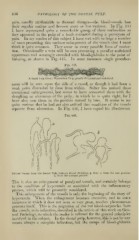Page 836 - My FlipBook
P. 836
846 PATHOLOGY OF THE DENTAL PULP.
pain, usually attributable to thermal changes—the blood-vessels lose
their regular outline and become more or less varicose. In Fig. 444
I have represented quite a remarkable group of these varicosities as
they appeared in the pulp of a tooth extracted during a paroxysm of
pain. In my studies of this subject I have met Avith so large a number
of cases presenting this varicose enlargement of the vessels that I must
think it quite common. They occur in every possible form of contor-
tion. Occasionally a vein will be seen presenting a peculiar nodulated
appearance and seemingly crowded with blood-globules to the point of
bursting, as shown in Fig. 445. In some instances single protuber-
FiG. 445.
A Small Vein from a Hypersemic I'uip, greatly distended and nodulated.
ances will be seen upon the side of a ves.sel, as though it had jjeen a
weak point distended by force from within. Salter has noticed these
aneurismal enlargements, but seems to have connected them with the
sloughing or ulceration of the pulp; in which he is quite right, for I
have also seen them in the position named by him. It seems to me
quite curious that he had not also noticed this condition of the vessels
separate from ulceration. In Fig. 446, I have copied his illustration.
Fig. 446.
Dilated Vessels from the Dental Pulp (Salter's Denfal Pathohfiy, p. 154): a, from the root portion;
6, from the coronal portion.
This is also an enlargement of paralyzed vessels, and certainly belongs
to the condition of hyperremia as associated with the inflammatory
process, which will be presently considered.
This enlargement of the vessels is only the beginning of the story of
hypersemia, When the enlargement becomes excessive, and in some
instances in which it does not seem so very great, another phenomenon
presents itself This is the migration of the red blood-corpuscles from
the vessels, as in infarction, described in the article of this work on Gen-
eral Pathology, to which the reader is referred for the general principles
involved in the snbject. In the dental pulp, however, this is not by any
means always a complete infarction, but the escape of blood-globules


